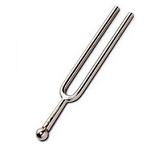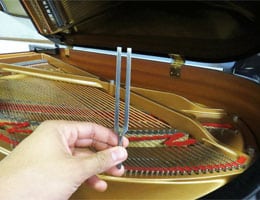 The term diapason comes from the Latin diapāson , which in turn has its origin in the Greek language. The notion is used in the field of music to name an interval formed by five tones (two minor and three major) and two major semitones (diatesarón and diapente), according to the first meaning mentioned by the dictionary of the Royal Spanish Academy ( RAE ).
The term diapason comes from the Latin diapāson , which in turn has its origin in the Greek language. The notion is used in the field of music to name an interval formed by five tones (two minor and three major) and two major semitones (diatesarón and diapente), according to the first meaning mentioned by the dictionary of the Royal Spanish Academy ( RAE ).
The concept, however, has other more frequent uses even in the same musical context. In stringed instruments , such as the guitar, violin and bass, the fingerboard is the section of wood that covers the neck and on which the strings are stepped on or plucked. When the instrument has frets, they are embedded in the fretboard.
The element that allows instruments and voices to be adjusted in terms of their tuning is also called a tuning fork. The tuning fork is a metal piece, invented by the British John Shore in the 18th century , which is shaped like a fork . The vibration of the tuning fork generates a sound that is taken as a reference when tuning an instrument, both one made by humans and the voice.
Depending on its material and shape, the tuning fork emits a specific sound (the most common is the note 440 , which has a frequency of 440 hertz). As the sine waves produced by the tuning fork always keep the tuning intact, its sound serves as a reference when trying to tune an instrument.
The 440 , in fact, has been considered a standard by the International Organization for Standardization for several decades. This makes the frequency of this sound the most frequent for tuning and, therefore, the reference sought on tuning forks.
Using a tuning fork can be as simple as it is complicated, depending on the goal the person is pursuing. First of all, it is necessary to learn to hold it and cause its vibration effectively; Then, we must bring it closer to our ear to finally hear the note it produces and use it as a reference point for tuning the desired instrument.
 It is important to note that the tuning fork is much more than a simple tuning tool : for the most passionate musicians, it is an essential travel companion that they always carry in their pockets. The tuning fork is often used even by people who have managed to train their ear to recognize the pitch of sounds without the need for an external reference (that is, those who have absolute hearing ), since its operation is practically infallible and, therefore, offers a reliability percentage greater than that of our brain.
It is important to note that the tuning fork is much more than a simple tuning tool : for the most passionate musicians, it is an essential travel companion that they always carry in their pockets. The tuning fork is often used even by people who have managed to train their ear to recognize the pitch of sounds without the need for an external reference (that is, those who have absolute hearing ), since its operation is practically infallible and, therefore, offers a reliability percentage greater than that of our brain.
Let's look at an example to understand the complexity hidden behind the use of the tuning fork. When a guitarist uses it to tune his instrument, he must combine it with a series of musical and technical knowledge that allows him to achieve his goal, since otherwise the reference note is of no use.
The Spanish guitar has six strings, which are numbered starting with the one at the bottom and must be tuned to the following notes: E, B, G, D, A and E. But this is not all, since the height of these notes must correspond to that of certain octaves of the piano: E 4, B 3, G 3, D 3, A 2 and E 2.
To be able to tune the Spanish guitar with the tuning fork, you also have to know the concept of musical intervals , which we can broadly define as the difference between two notes, both in height and frequency, something that is also useful for locating one's own. a certain note with the voice: if we know how to mentally calculate an interval, such as a major fourth, we can take A 440 and sing a D natural without problems.
